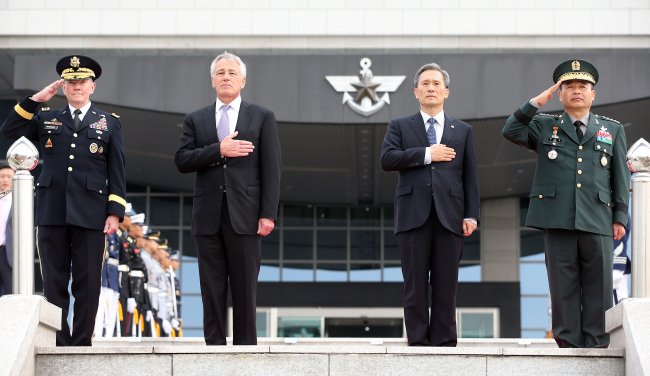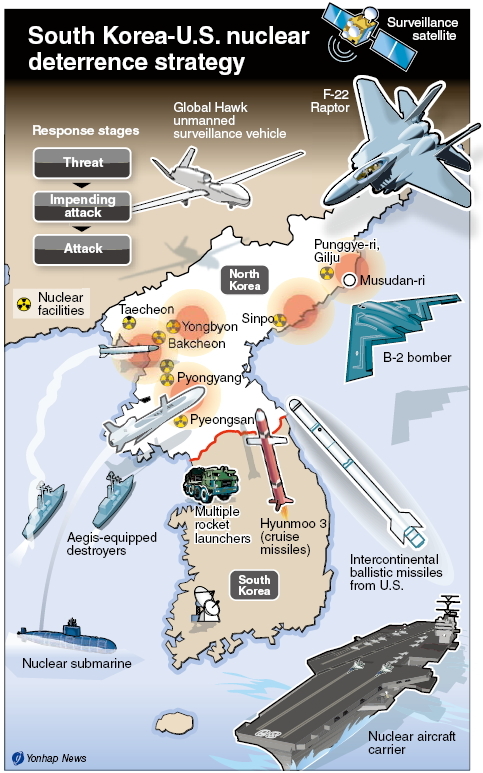 |
Korean Defense Minister Kim Kwan-jin (second from right), Joint Chiefs of Staff Chairman Jung Seung-jo (right), U.S. Defense Secretary Chuck Hagel (second from left) and Joint Chiefs of Staff Chairman Martin Dempsey inspect an honor guard at the Defense Ministry headquarters in Seoul on Wednesday. (Yonhap News) |
Seoul and Washington focused on bolstering deterrence to counter increasing nuclear and missile threats from North Korea during their annual high-level defense talks in Seoul on Wednesday.
During the annual Security Consultative Meeting, Defense Minister Kim Kwan-jin and his U.S. counterpart Chuck Hagel endorsed the allies’ tailored deterrence strategy and agreed to bolster cooperation in missile defense and security in space and cyberspace.
Touching on the increasing nuclear and missile threats from North Korea, the defense chiefs stressed that “conditions” should be met before the transfer of wartime operational control, which is currently slated for December 2015.
They also agreed to the allies’ military-level deal to virtually retain their Combined Forces Command, which was to be dissolved following the OPCON transfer.
One of the key agreements at the SCM was the completion of the tailored deterrence strategy, a set of more concrete military and non-military procedures to deal with threats from North Korea’s nuclear arms and weapons of mass destruction.
The assets that would prop up the strategy include the U.S.’ full range of capabilities including its nuclear umbrella and its conventional strike and missile defense capabilities. Seoul would strengthen deterrence with its Kill Chain system, an envisioned preemptive strike program.
A senior Seoul official said it was the first time for the U.S. to put forward concrete steps for its stated commitment of extended deterrence. He noted that Washington has offered extended deterrence to its allies without clear procedures for particular premeditated scenarios.
 |
(Yonhap News) |
For the deterrence strategy, the allies have been consulting over how the U.S. would provide the South with its stated “extended deterrence.” The bilateral consultations over the strategy have taken place at their Extended Deterrence Policy Committee, which was set up in 2010 following North Korea’s lethal provocations in the year.
Regarding the OPCON transfer, the allies agreed on the need to carry out their new evaluations of security conditions, which are considered far worse than those in 2007 when the two sides set the 2015 timetable.
Last May, Defense Minister Kim requested that the allies reconsider the timing of the OPCON handover. He had stressed that the communist state had increased its military threats after its third underground nuclear test in February and successful launch of a rocket with an estimated range of some 10,000 km, far enough to hit the U.S. mainland.
Initially scheduled for April 2012, the transfer was first delayed to the end of 2015 in June 2010 amid Pyongyang’s continuing provocations, including the torpedoing of the South Korean corvette Cheonan that killed 46 sailors.
During the SCM, the two defense chiefs also approved the basic plan regarding the allies’ future military commanding structure that would be applied after the OPCON transfer.
As the Joint Chiefs of Staff chairmen agreed earlier this year, Kim and Hagel endorsed the command structure under which a South Korean general leads the combined forces in case of a peninsular contingency. There has been some skepticism that the U.S. might be reluctant to put its forces under the command of a foreign flag’s officer.
Also with the agreement, the allies would virtually retain the core features of the Combined Forces Command, which was set to be dissolved following the OPCON handover.
“The allies would inherit the merits and the know-how of the CFC and build the Combined Theater Command and combined components of armed services with an aim to ensure efficient decision-making procedures,” a Seoul official said, declining to be named.
In their joint efforts to counter Pyongyang’s missile threats, the allies are expected to bolster cooperation in enhancing interoperability of their separate missile defense systems.
“We want systems that work together, that are interoperable. This involves a lot of command and control and it is complicated,” said Hagel during a press conference after the SCM talks.
Seoul has been reluctant to joint the U.S.-led global missile defense program as it could hurt ties with Beijing and Moscow, which think the U.S. system could target them in case of a contingency.
Instead, it has been working on developing its own low-tier defense system, which is different from the U.S.’ comprehensive, multilayered missile shield network that seeks to link Japan and other regional allies.
By Song Sang-ho (
sshluck@heraldcorp.com)






![[Exclusive] Hyundai Mobis eyes closer ties with BYD](http://res.heraldm.com/phpwas/restmb_idxmake.php?idx=644&simg=/content/image/2024/11/25/20241125050044_0.jpg)
![[Herald Review] 'Gangnam B-Side' combines social realism with masterful suspense, performance](http://res.heraldm.com/phpwas/restmb_idxmake.php?idx=644&simg=/content/image/2024/11/25/20241125050072_0.jpg)

